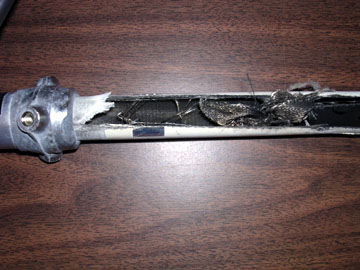Welcome to Handiham World!
We are back again after a vacation week. Our family spent a week on the North Shore of Lake Superior, and I found out some interesting things about operating from the hotel via the Internet. As you might expect, one typically operates a notebook computer at such a location via a wireless connection to the hotel's wireless router. This particular hotel, which was really more like rental condominiums, had an unsecured wireless router. This may seem unusual, but we were so far north "in the sticks" that I imagine security concerns don't crop up all that much. One advantage for the hotel is that there are fewer tech support calls from guests having trouble logging on to the system. So far, so good. It was easy to connect to the hotel Internet system, and there were no annoying login screens like the ones typically encountered at major hotel chains. Sometimes security software and firewalls get in the way of ham radio operation via the Internet, so a test of the system is always in order. Most of us who have operated EchoLink are familiar with firewall issues, and when I am traveling I assume that I am going to have to operate EchoLink through a proxy in order to bypass firewalls at hotels and coffee shops. Of course you can always run a simple test with EchoLink in the normal (non-proxy) mode to see what happens. You should see a station list, and if you are often dealing with firewall issues like me, you probably have the EchoLink test server already bookmarked in your favorites. You need to try a test connection to the EchoLink test server. If it fails, the next step is to select a proxy from the public proxy list and try the test server again. If it works, you are good to go!
The interesting thing that I encountered -- something I had never seen before -- was that the connection through a proxy was successfully made and allowed perfectly normal reception. The oddity came when I transmitted and got reports that everything I said was vastly speeded up, although the pitch of my voice was not changed. "Dead air" punctuated the speeded up speech. This was most interesting; it was certainly nothing I had ever experienced before in using EchoLink. It certainly wasn't caused by the proxy, which is my own WA0TDA proxy running on a high-speed Internet connection. It wasn't the Dell netbook computer, which I had used many times for successful EchoLink QSO's. It pretty much had to be the hotel wireless system, which was delaying packets and then dumping them out all at once. Still, it seemed odd that this only happened on transmit and audio was perfectly normal while receiving. One would certainly think that the phenomenon would be the same in both directions. I would be interested in hearing from any of our readers and listeners who can shed some light on this strange EchoLink behavior.
That EchoLink problem prevented me from getting on the handiham net, but I still had the handiham remote base software installed on the Dell along with Skype, so I decided to check into PICONET, a daily HF net on 3.925 MHz. Interestingly enough, the rig control software behaved perfectly normally and I was able to easily control the Kenwood TS-480 transceiver at Courage North. Skype transported the audio as expected, delivering both excellent reception and good reports on transmission. Clearly Skype and EchoLink are very different applications and route audio packets differently over the Internet. Although it is possible to operate a remote base station using EchoLink, this only served to confirm that we made the correct decision to choose Skype as the audio transport system for the handiham remote base instead of EchoLink. Skype is much more likely to work the first time without a need to worry about firewalls, proxies, port forwarding, and all the rest.
Now, as we get closer to the release date of Windows 7, we need to continue testing to determine how the handiham remote base software and EchoLink will work in this new operating system that will ultimately replace Windows XP and Windows Vista. If anyone has experience with testing using the Windows 7 beta or the current Windows 7 release candidate, let me know so that we can compare notes. We want to make sure that the handiham remote base is reliable and accessible for all users, whether they are operating from a hotel room or from their home Internet connection.

Photo: Lightning destroyed this fiberglass antenna at Handiham headquarters several years ago. The antenna literally blew apart, but gas-discharge arrestors protected the station equipment.
 Before we move on to Avery's QTH, I want to remind you that it is thunderstorm season in much of the northern hemisphere. Yesterday afternoon I went out for a walk, my typical 2 mile trek through the local park. When I left the house, I stepped into bright sunshine. Halfway through the walk, cumulus clouds had grown quickly, getting darker and larger, and thunder was evident. When conditions are right, thunderstorms can sprout quickly as the strong sunlight causes air to warm and rise. And there I was, a mile from home with no umbrella, and no protection from lightning, wind, or hail!
Before we move on to Avery's QTH, I want to remind you that it is thunderstorm season in much of the northern hemisphere. Yesterday afternoon I went out for a walk, my typical 2 mile trek through the local park. When I left the house, I stepped into bright sunshine. Halfway through the walk, cumulus clouds had grown quickly, getting darker and larger, and thunder was evident. When conditions are right, thunderstorms can sprout quickly as the strong sunlight causes air to warm and rise. And there I was, a mile from home with no umbrella, and no protection from lightning, wind, or hail!
Well, I hoofed it back home as quickly as I could, with the thunder getting louder and the sky getting even darker. I wasn't all that worried about getting wet, but lightning scares me, and I knew that I needed to be under shelter as soon as possible. Besides, all of my station's antennas were still connected, putting my radios at risk.
As it happened, I made it home without getting rained on, the station was unscathed, and the storm moved off. Later that evening, I heard on the news that a 14 year old girl in a nearby city, only about 12 miles away, had been struck by lightning and killed. She had been playing outside in the rain when the tree she was under was struck.
Lightning is unpredictable, and it is more dangerous than the wind and rain. Lightning has been known to strike 10 to 15 miles from the storm cloud! I was lucky this time, but it does serve as a reminder to check the weather radar before going outdoors for an extended period during these unsettled summer weather conditions. This wouldn't be a bad time to check your ham shack's grounding and lightning protection systems, too! Remember, summer is the time when the day can dawn bright and clear, but thunderstorms can pop up suddenly, drawing massive energy from the hot sun. Disconnect those antennas unless you are actually using your station, just to be on the safe side.


 Before we move on to Avery's QTH, I want to remind you that it is thunderstorm season in much of the northern hemisphere. Yesterday afternoon I went out for a walk, my typical 2 mile trek through the local park. When I left the house, I stepped into bright sunshine. Halfway through the walk, cumulus clouds had grown quickly, getting darker and larger, and thunder was evident. When conditions are right, thunderstorms can sprout quickly as the strong sunlight causes air to warm and rise. And there I was, a mile from home with no umbrella, and no protection from lightning, wind, or hail!
Before we move on to Avery's QTH, I want to remind you that it is thunderstorm season in much of the northern hemisphere. Yesterday afternoon I went out for a walk, my typical 2 mile trek through the local park. When I left the house, I stepped into bright sunshine. Halfway through the walk, cumulus clouds had grown quickly, getting darker and larger, and thunder was evident. When conditions are right, thunderstorms can sprout quickly as the strong sunlight causes air to warm and rise. And there I was, a mile from home with no umbrella, and no protection from lightning, wind, or hail!